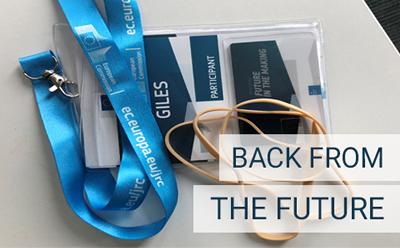
Read more on the evidence informed policy making
Learn more from Gavin Cistigan, Public Policy|Southampton Director about the evidence informed policy making and the role of universities

Full disclosure: I’m not a futurologist. In fact if truth be told I’m fairly cynical about anyone who says they have a tool that helps them to see the future. So as the plenary session opened on the sixth FTA (Future-Oriented Technology Analysis) I was certain that I was well inoculated to what would follow. The session had a distinct tech conference feel; cool haircuts, a high Apple device to people ratio, plenty of Slido polls and littered with Silicon Valley lexicon (‘Let’s understand the present by viewing it from the future’ - particularly stuck in the craw). So far, so comfortingly reaffirming of my preconceptions.
The following parallel sessions tossed in (what I now know are referred to as) a few mind bombs. Far from talking about techniques to understand our currently highly fluid global political landscape the good ship FTA2018 sloshed around from one tempest to another in a few short hours. Speakers tackled how diminished youth faith in institutions meant that democracy needed to be reimagined, that the EU is stuck in a Sisyphean cycle of defining its values and stating them but never quite developing values based policy and asking whether the EU has the collective ambition to assert itself in the post unipolar world. Having travelled from Brexitland it was somewhat jarring to remember that while the UK is stuck in shallow water working out what Brexit might mean, the rest of Europe was looking to chart a course into stormy seas to a destination unknown. A little demoralised that futurologists seemed relatively good at identifying the problems of present (and seemingly without need to look back from the future) we came together again for second plenary of the day.
In the Q&A to Stephen Boucher’s keynote ‘Future of Foresight for Policymaking’, one bold questioner asked ‘Foresight has been around for 30 years. Why isn’t it already embedded in policymaking? What is the elephant in the room here?’ My ears pricked up: had someone noticed that the emperor had no clothes? Well, kind of. Rattled by the hall’s ripple of nervous laughter, Stephen uttered ‘Showing impact is, well, it is hard’. My satisfaction with his answer was immediately tempered by empathy. In my world of attempting to influence policymakers with evidence, I come up against the rapidly swirling policy cycle, ideology and geek to wonk translation issues. So I knew immediately what he meant. It is hard to demonstrate change in policy outputs or development. Policy is constructed ‘behind the curtain’ in an intensely political environment and against the clock. It is coloured by a bid to maintain a veil of public credibility by appearing to have all the answers. Policymakers (and especially politicians) wish to demonstrate they have the answers to the problems of the world and aren’t necessarily keen on admitting that they had a little help along the way. While maintaining this pretence is good politics and probably fine in the scheme of things, it doesn’t align with the current need for researchers in the UK to demonstrate the impact of their work. So I found myself in agreement with Stephen, demonstrating impact is hard.
Stephen moved on ‘I have spent twenty years persuading policymakers that Foresight is important’ - with you there too Stephen. Evidence based policymaking is a far harder sell than policy based evidence making. Finally, he said that over his career too frequently Foresighters had followed the hype rather than provoked it. I get that too, though in my corner of the policy-influencing world I advise researchers to scan the horizon for passing bandwagons and lash themselves to it in order to get their findings heard by decision makers. Though researchers by and large aren’t in the prediction business, so that’s less of an issue for us. Finally and perhaps most profoundly Foresighters seem focused on spotting the wild card scenario that might deflect an intervention from achieving its goals. This is a fundamental mismatch with policymakers instinctive desire for solutions, ideally within the current election cycle, rather than low probability unintended consequences. Time and again with the researchers I work with we talk about providing evidence to policymakers that is usable, i.e. it will support the process of getting to a solution. That could be saying that that won’t work because of X and Y. It could be saying evidence indicates that that could work. By all means add error bars, by all means say this is the probable outcome but just don’t say that further research is required! As the first day came to a close I felt a little closer to understanding the frustrations of Foresighters but no closer to understanding what they exactly they do and why policymakers should listen to them.
Having successfully had my mind blown on day one, day two started to put it back together. Determined to find out what they actually did I attended parallel sessions focused on how Foresighters have worked with local, regional and national governments to develop policy. Finally with examples from around the world Foresight began to come into focus. The choice of the right stakeholders(/actors) at the right time follows closely with methods of influencing policymaking with evidence. Particularly clarifying were sessions from Jonathan Blanchard Smith and Wendy Schultz from SAMI Consulting (a spin out from St Andrews University) about techniques to debiase scenario planning for stakeholders, knowing whether your stakeholders will respond best to baby steps or mind bombs and the rubber band technique* to empower stakeholders to widen their aperture for change. All this makes a lot of sense. Its benefits lay in looking beyond the five year cycle, bringing people together and provoking people to think more expansively about what could be.
So as the Eurostar effortlessly pulls me back to Brexitland what are my thoughts on two days peering into the world of those peering into the future? I’m certainly empathetic to the challenges Foresighters experience when attempting to influence policy. It's hard to do well and even harder to get credit for it. Does Foresight have a place in policymaking? Probably, but the time it takes to do this work makes it challenging to tether to the policy cycle. Can Black Swan events be predicted and preempted? Almost certainly not and with many European capitals struggling to govern against a backdrop of ongoing austerity, it is a hard argument to win that precious resources should be devoted to this endeavour. Foresight’s long termism and desiloing are valuable exercises, no doubt, but would require a cross party consensus that is evidently lacking in the current oppositional politics we find ourselves in. It’s not all doom and gloom, bringing policymakers together with stakeholders and critically those who will be impacted by interventions will surely make for better policy than policy made isolation. Though what do I know? I can’t see into the future.
G Giles
Policy Manager at
Public Policy|Southampton
* Rubber band technique involves getting participants to look back at the tech, social and personal events during their life, then to repeat the process again this time going back another lifetime (i.e. the year of their birth minus their current age). This process should assist participants in realising that they have lived through vast change and so did the generation before them and so participants feel more comfortable with a imagining a broader scope of change in the next two generations.
Want to find out more about FTA2018? You can find papers from the conference here, the programme here and catch up with all the chatter via its twitter channel here – enjoy!

Learn more from Gavin Cistigan, Public Policy|Southampton Director about the evidence informed policy making and the role of universities

Catch up with past articles from researchers at the University of Southampton